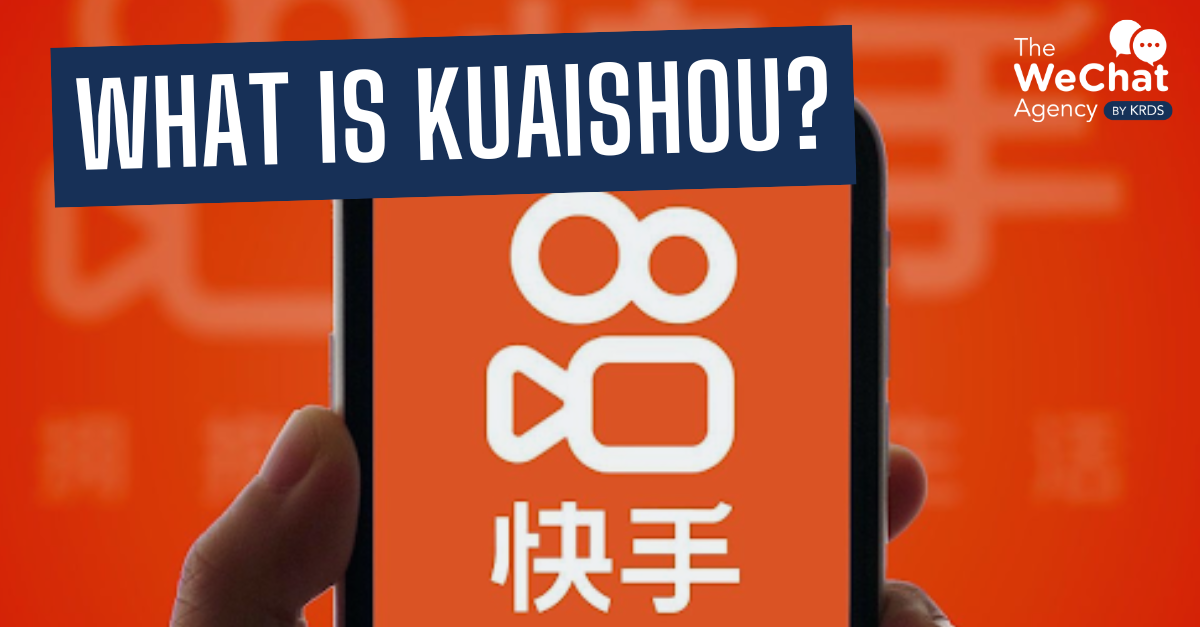WeChat is the major platform leading China’s digital transformation. A “mega app” that encompasses major successful features of most western and Chinese platforms: Blog-like articles, digitally interactive experiences, WeChat Pay, e-commerce & e-booking with WeChat Mini Programs, Moments (a virtual space to share daily updates), Channels (for visual-led content), live streaming, enterprise solutions, even search engine, and more.
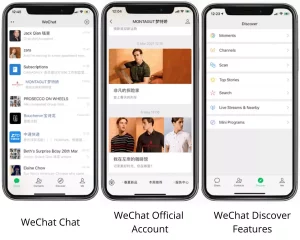
This Chinese social media has established itself as a major platform for content creation through articles and channels, now the roadmap for Tencent (WeChat’s owner) is to leverage Miniprogram to boost business growth further, as it has become part of users’ daily life, develop futuristic features on WeChat Pay, and make WeChat Search a user habit. This is a rapidly changing platform and brands need to keep up if they want to stay relevant to Chinese users.
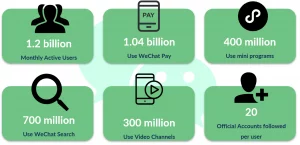
WHAT IS WECHAT MARKETING?
-
Understanding the WeChat Ecosystem:
In the past three years, WeChat marketing and advertising underwent tremendous changes. With the emergence of the new social media apps, it proved that it’s not going away and also managed to strengthen its position by continuously adapting to the new consumer behaviours by expanding its features and consolidated its position as a top app in China.
We have observed new trends emerging while strengthening existing ones. Some of the major trends that took off were:
- WeChat channels & Live-streaming,
- WeChat work (WeCom),
- Relevance of mini programs,
- Focus on content creators,
- Smart targeting.
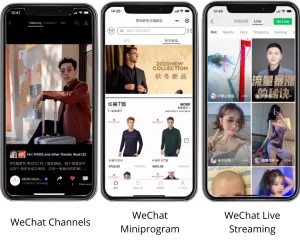
-
Select the right WeChat Official Account for your brand:
There are mainly 2 types of Official Account: WeChat Service Account & WeChat Subscription Account.
WeChat service and subscription accounts offer very different user experience hence the user journey and landing on the article vary.
WeChat service Accounts have the same priority as a user’s contacts in terms of notification status and appear on the main page in chronological order.
WeChat subscription accounts are gathered in a separate folder where accounts are shown according to an algorithm (most often read accounts) compared to the chronological order before.
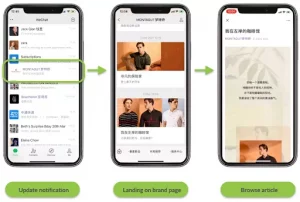
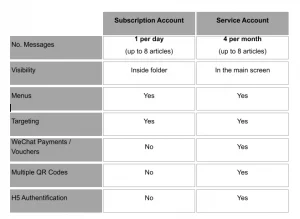
-
Audit of other players & Gap Analysis
Identifying Key Players’ Strategy
Identify the key players in China. To do so, it is important to examine the activity and performance of your competitors on WeChat.
How to do the screening?
- Quantitative and qualitative data including views, comments, likes, wows to illustrate share of voice of each player to provide a detailed comparison of the landscape
- Audit of the key content pillars, tone of voice, content formats, and top performing posts from to compile the standard of what’s out there within WeChat
- Competitors’ menu and overall official account usability
- Overview of the strategies employed by B2B/B2C companies and their relevance for your brand
Gap Analysis & Key Learnings
Analyzing areas where other key players are lacking, what kind of content or type of information is missing and identifying gaps that could potentially become an opportunity in the future for your brand’s own communication.
-
Identifying your Target Audience in China:
Chinese Netizens
Understanding who a Chinese internet user is becomes crucial to reach the right audience with the right channels and communication methods. Each Chinese platform, be it Weibo, RED (Xiaohongshu) or Kuaishou is characterized by a different user profile and same goes for WeChat.
WeChat is used on a daily basis by more than one billion people, it’s a huge and extremely diversified crowd. With precise segmentation, you will be able to reach your desired target audience with the most aligned messaging and maximize the ROI on WeChat.
Who is your Target Audience on WeChat?
The first task is to define your target audience and understand their main characteristics, social behavior, consumption patterns and what are the key trends among the group.
Secondly, examine how they behave on WeChat, what kind of content they interact with and what is their peak activity time on the platform to reach them with the right messaging at the right time.
Try to create a very detailed target audience personas to get a full portrait.
Different Communication for Different Audiences
We recommend pushing personalized messaging for the different target audiences.
Based on the personas you created, your brand on WeChat can do a backend segmentation or WeChat CRM system can share to a selected audience different WeChat articles at different times. Because everyone likes special treatment, explore how backend tagging and CRM can improve your customers’ user journey.
To do that, analyze your target audience again and what are their key preferences and motivations and define your content pillars based on that.
Content that is better tailored to users needs and expectations will perform better and decrease the risk of unfollowing by the fans. It would also improve the overall user experience if the users don’t find the receiving content too intrusive or irrelevant. You can also consider sending additional, targeted posts to segmented followers on top of regular communication for all.
-
Define your Content Strategy
WeChat is already a highly saturated space with many accounts pushing quality content on a regular basis, either in the form of posts or WeChat ads. An average WeChat user only follows around 20 public accounts and spends around half an hour per day reading articles. It’s not easy to make it into this within a short period of time. This can be achieved with a clear vision of your target audience and perfectly crafted content.
WeChat Content
In very basic terms, WeChat marketing strategy can be divided into content format and content topics. Beyond articles, the WeChat ecosystem offers many components that could be leveraged by brands in many interesting ways – official account menu, welcome message, H5, videos and more.
We also recommend preparing different content for different target audiences and for fans at different stages of relationship with your brand e.g. new followers, potential customers, repetitive customers.
WeChat Content Formats
Depending on the goal you want to achieve, you might want to choose different content types or combination of more touchpoints to take your communication to the next level. Top-notch account optimization is a requirement for successful interaction with your fans on WeChat, then you can experiment with different formats and styles of your WeChat articles and campaigns.
WeChat Content Pillars
What are the most important topics that you would like to share with your fans and what are the topics that are the most interesting to your social personas? Focus on these areas and find a balance between brand and social-led content.
Determine the frequency of each topic and try to stick to it to not overwhelm your audience with similar stories all the time.
-
Other Features to Leverage
WeChat is much more than articles – Tencent is constantly expanding its ecosystem of features that can be used by brands. In the past couple of years, new tools such as WeCom (previously WeChat Work), Mini programs, WeChat Channels, WeChat Search (Sou Yi Sou) or WeChat Beans have been introduced and we can only expect to see further new updates each year.
Try to follow the latest WeChat/Weixin news and experiment with new tools to keep up with the changes taking place on WeChat and Chinese social media.
Take a look at some of the key tools that you can use in your brand communication on WeChat.
- Interactive posts,
- WeChat Channels,
- Mini programs,
- H5 pages,
- Surveys,
- Live-streaming,
- Coupons,
- and more.
-
Distribution & Amplification
Because WeChat is a semi-closed platform a thoughtful and well-executed content amplification plan is a must. Every day and every hour, WeChat users are bombarded with articles from millions of WeChat official accounts competing for their attention and clicks. It’s crucial to make sure that your carefully prepared content reaches your target audience in the most effective way. Let us help you to discover multiple touchpoints through which WeChat content can be accessed and understand different methods of content amplification, both organic and paid, to make sure that your WeChat marketing and distribution strategy covers all of them.
48 hours
Lifespan of a WeChat post is extremely short. The most critical time is the first 48 hours after the publication – this is when 90% of reads and interactions happen and the rest usually within total 7 days after the publication. Therefore it’s extremely important to grasp this moment to keep the ball rolling and ensure that the post is 100% optimized for WeChat and checks the boxes of shareability or the ‘wow’ factor.
When you post a new article, WeChat users first see the preview of the post. When your brand secures at least the opening of the article, you can work towards a positive reaction, for example share or ‘wow’.
Organic distribution
By organic distribution, we mean all the promotion methods that you don’t need to pay for and purely utilize your own resources. Keep in mind that these methods can be relatively time consuming and require some effort on your and your team’s end. Some of our favorite organic methods include:
- Optimized WeChat SEO,
- Private traffic management,
- Backlinking to previous articles,
- Internal teams mobilization to spread articles (sharing, wow, Moments),
- Collaborations with other partner accounts,
- Linking from WeChat Channels video.
Paid promotion
Due to the semi-closed nature of WeChat and a more and more saturated environment, especially when it comes to official accounts, organic reach is decreasing with each year. On the other hand, paid promotion like WeChat ads can get you very far and help you to reach millions of new potential customers.
The main two types of official accounts to get followers and articles views are:
- WeChat Moments ads,
- WeChat Banner ads.
WeChat Moments ads — displayed within user’s friends’ updates on Moments. WeChat strictly limits the number of ads displayed to each user on their Moments and when scrolling though Moments for a longer period of time, the user might come across max. 3 ads. A Moments ad can drive users to a landing page, video, mini program, shop, coupon and more. This type of ad is suitable for big-scale campaigns as the minimum budget required by Tencent is 50,000 RMB (7,500 USD).
WeChat Banner ads — usually displayed at the end of a WeChat article, banner ads can drive users to follow a WeChat Official Account, view articles, download an app, signup link or to a customized landing page. Much more affordable than WeChat Moments ads, you can start promoting with minimal budget.
KOL marketing
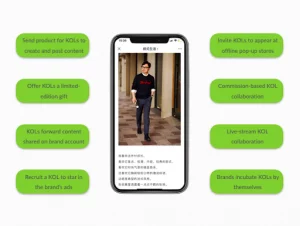
If you follow Chinese marketing trends closely, then you are probably already familiar with the KOL marketing. KOL, which stands for Key Opinion Leader, is a fastly growing way of promoting your brands with the help of influencers. Brands fell in love with this kind of marketing because compared to Western influencer marketing, KOLs are perceived as more trustworthy in opinion of the Chinese consumers and this trend doesn’t show any signs of slowing down. You can choose from a wide range of big and small KOLs across different industries.
You can adopt various strategies when working with Chinese KOLs.


